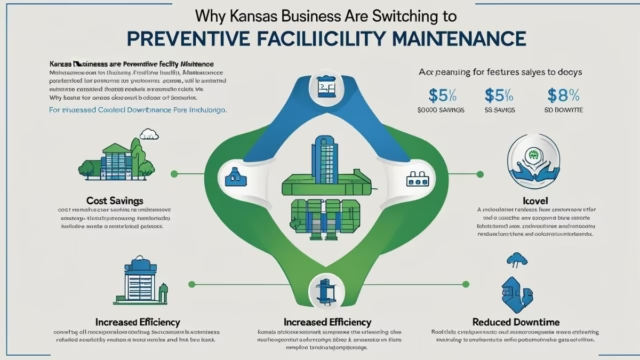Imagine that It’s the middle of January in Kansas, temperatures are hovering around 15°F, and your heating system decides to call it quits. Your employees are shivering, customers are walking out, and you’re staring down a repair bill that could easily hit five figures. Sound familiar?
If you’re nodding your head, you’re not alone. Every year, thousands of Kansas business owners face this exact nightmare – and it’s completely preventable. The difference between businesses that thrive and those that constantly battle equipment crises isn’t luck – it’s strategy. Smart Kansas business owners have discovered something game-changing: preventive maintenance doesn’t just prevent disasters; it actually puts money back in their pockets.
The Real Cost of “Wait and See”
Most business owners think they’re saving money by waiting until something breaks before fixing it. It’s the classic “if it ain’t broke, don’t fix it” mentality. But here’s what that approach really costs:
Sarah’s Restaurant Story Sarah owns a popular steakhouse in Wichita. Last winter, her ancient boiler finally gave up during the dinner rush on Valentine’s Day – their busiest night of the year. Not only did she lose $8,000 in revenue that evening, but the emergency repair cost her $12,000. The kicker? A maintenance technician had warned her about the boiler’s condition just six months earlier. A $300 tune-up could have prevented the entire disaster.
The Hidden Expenses Add Up Fast When equipment fails unexpectedly, you’re not just paying for repairs. You’re dealing with:
- Lost productivity while employees work in uncomfortable conditions
- Potential inventory loss (think frozen pipes bursting or refrigeration failing)
- Emergency service rates that can triple your repair costs
- Customer complaints and negative reviews
- Insurance claims and potential liability issues
What Smart Kansas Businesses Are Doing Instead
Forward-thinking business owners across Kansas are making a simple switch: they’re investing in preventive maintenance instead of playing equipment roulette.
Meet Tom’s Manufacturing Success Tom runs a small manufacturing plant in Topeka. Three years ago, he was spending about $25,000 annually on emergency repairs. His production line would shut down at least once a month due to equipment failures. Today, after implementing a preventive maintenance schedule, his annual maintenance costs dropped to $8,000, and he hasn’t had an unplanned shutdown in over 18 months.
The math is simple: Tom now saves $17,000 every year, plus the thousands more he would have lost in downtime and missed deadlines.
The Science Behind Preventive Maintenance
Think of your building’s systems like your car. You wouldn’t wait for your engine to seize up before changing the oil, right? The same logic applies to your HVAC, plumbing, electrical, and other building systems.
Regular maintenance catches small problems before they become big disasters. A loose belt gets tightened before it snaps. A small leak gets sealed before it becomes a flood. Dirty filters get replaced before they cause system failures.
The 80/20 Rule in Action Studies show that 80% of equipment failures are caused by issues that could have been caught during routine maintenance. That means most of the headaches you’re dealing with are completely avoidable.
Real Numbers from Real Kansas Businesses
Let’s talk specifics. Here’s what Kansas businesses are actually saving:
Energy Costs: Well-maintained HVAC systems use 15-20% less energy. For a typical Kansas business, that’s $2,000-5,000 in annual savings.
Equipment Lifespan: Preventive maintenance can extend equipment life by 30-50%. Instead of replacing that $15,000 HVAC unit every 8 years, you might get 12-15 years out of it.
Emergency Repairs: Businesses with maintenance contracts report 70% fewer emergency calls. No more panic, no more triple-time weekend rates.
Downtime: The average Kansas business loses $5,000 for every hour of unplanned downtime. Multiply that by how many hours you’ve lost to broken equipment, and the numbers get scary fast.
What Does Preventive Maintenance Actually Include?
You might be wondering what you’re actually getting with facility maintenance services in Kansas. Here’s the typical checklist:
HVAC Systems: Filter changes, belt inspections, refrigerant level checks, thermostat calibration, duct cleaning, and seasonal tune-ups.
Plumbing: Pipe inspections, drain cleaning, water pressure checks, fixture maintenance, and backflow testing.
Electrical: Panel inspections, outlet testing, lighting maintenance, emergency system checks, and power quality assessments.
General Building: Roof inspections, window and door maintenance, flooring care, and exterior upkeep.
The Best Part? Most maintenance providers will customize a plan based on your specific building and equipment. You’re not paying for services you don’t need.
Making the Switch: What to Expect
When Kansas businesses first make the switch to preventive maintenance, here’s typically what happens:
Month 1-3: The maintenance team does a comprehensive assessment of your building systems. They’ll identify existing problems and prioritize what needs immediate attention versus what can wait.
Month 4-6: You’ll start seeing fewer surprise breakdowns. Small issues get caught and fixed before they escalate.
Month 7-12: The real savings start showing up. Lower energy bills, fewer emergency calls, and better overall system performance.
Year 2 and Beyond: This is where the big money gets saved. Equipment lasts longer, operates more efficiently, and breaks down far less frequently.
The Bottom Line for Kansas Business Owners
Here’s the reality: You’re going to spend money on building maintenance either way. The question is whether you want to spend it on your terms or at 2 AM on a Sunday when everything’s broken and you’re paying emergency rates.
Preventive Maintenance: Planned, predictable costs that save you money over time.
Reactive Maintenance: Unpredictable, expensive emergencies that always seem to happen at the worst possible moment.
The choice is yours, but the smart money is on prevention.
Getting Started: Your Next Steps
If you’re ready to stop playing equipment roulette and start saving money, here’s how to begin:
- Audit Your Current Situation: Look at your maintenance and repair expenses from the past two years. How much did you spend on emergency repairs? How many times did equipment failures disrupt your business?
- Identify Your Critical Systems: What equipment would shut down your business if it failed? Start your preventive maintenance program with these systems first.
- Find the Right Partner: Look for facility maintenance services in Kansas that understand your industry and can customize a program for your specific needs.
- Start Small: You don’t have to do everything at once. Begin with your most critical systems and expand the program as you see results.
- Track Your Results: Keep records of your maintenance costs, energy bills, and equipment performance. You’ll want to see the concrete savings you’re achieving.
Conclusion
The choice is crystal clear. You’re going to spend money on building maintenance – that’s inevitable. The only question is whether you’ll spend it wisely on prevention or wastefully on emergencies that always seem to hit at the worst possible moment.
Kansas businesses that have made the switch to preventive maintenance aren’t just avoiding disasters they’re building competitive advantages. While their competitors deal with unexpected breakdowns, lost customers, and emergency repair bills, these smart business owners are running smoothly, saving thousands, and focusing on what really matters: growing their business.
The transformation doesn’t happen overnight, but it happens consistently. Month by month, you’ll see fewer surprises, lower bills, and better performance from your building systems. Your equipment will last longer, your energy costs will drop, and you’ll sleep better knowing you’re not one breakdown away from a business crisis.
Every day you delay is another day you’re gambling with expensive equipment failures. Every other Kansas business owner who makes this switch before you do is gaining an advantage you’ll have to work harder to match later.
Your building’s systems are already giving you signals, unusual sounds, minor leaks, fluctuating temperatures. The question is whether you’ll listen to these early warnings or wait until they become expensive emergencies.
The businesses that thrive in Kansas are the ones that think ahead, plan for success, and invest in prevention rather than paying for disasters. The opportunity to join them is right in front of you.






